Experimental Research on a Solar Energy Phase Change Heat Storage Heating System Applied in the Rural Area
Abstract
1. Introduction
2. Materials and Methods
2.1. The Phase-Change Heat Storage Device
2.2. The Design Method of Solar Energy Collection System
2.3. The Phase-Change Thermal Storage Solar Heating System
2.3.1. System Theory
- Solar heat storage process: When the water temperature of the outlet of the solar collector (1) meets the requirements, open the valve V1/V2/V3/V4/12 and close other valves. Additionally, start the water pump (5), and PCHSD (2) will begin to store heat.
- Electric heat-storage process: Open valve V5/V6/V7/13 and close other valves. Electric heater (3) and water pump (6) are turned on to carry out electric heat storage for PCHSD (2).
- Heating process: Open the valves V5/V6/V8/V9/V10/V11/13, close the other valves, and PCHSD (2) begins to heat the room.
2.3.2. The Automatic Control Strategy
2.3.3. The Operating Mode
- Mode 1. When daytime solar radiation is too weak, it is difficult to fill the device with solar energy alone. In this case, electric heat storage is needed to replenish heat after solar heat storage;
- Mode 2. When daytime solar radiation is too weak and the outdoor temperature is low at night, delay the reheating time of electric heat storage relative to operating mode 1;
- Mode 3. When the daytime solar energy is sufficient to fill the device, intermittent heating is used at nighttime;
- Mode 4. When the time-of-use power price (TOU) is implemented, electric heat storage can be used at night to replenish heat for the device.
2.4. Performance Indicators
2.4.1. Performance of Phase-Change Heat Storage Device
2.4.2. Renewable Energy Efficiency
2.4.3. Indoor Thermal Comfort
2.4.4. The Economic Indicator
3. The Experiment Setup
3.1. The Experiment Building
3.2. Experimental Platform for the Heating System
3.3. Experimental Data Collection
4. Results and Discussion
4.1. Performance Analysis of Device
4.1.1. The Heat Storage
4.1.2. The Heat Release
4.1.3. Thermal Efficiency
4.2. Indoor Thermal Comfort
4.3. Renewable Energy Efficiency
4.4. System Economy
5. Conclusions
- The phase-change heat storage device shows good thermal performance in the practical application of the heating system. The thermal efficiency varies with operating modes, but it is higher than 46.2% and even as high as 85.8% under all operating modes.
- The low thermal conductivity of phase-change materials seriously affects the heat storage efficiency. In this experiment, fins are added to the device to improve the poor thermal conductivity of the system and materials. In subsequent studies, phase-change materials can also be made into phase-change composites by adding expanded graphite, multilayer graphene and nanoparticles with high thermal conductivity, which can improve the heat storage rate of materials on the basis of ensuring energy storage efficiency.
- The experimental room maintained better thermal comfort performance under four operating modes, and the thermal comfort ratio in operating modes 1–4 was 67%, 66%, 85.1%, and 100%, respectively. The combination of a good-performance heat storage device and a reasonable operating mode is a necessary condition for the heating system to use intermittent heating.
- The renewable energy efficiency of the system is positively correlated with the solar radiation intensity, which fluctuates between 9% and 100%. When there is enough solar energy during the day (operating modes 3 and 4), solar energy can be used as the only heat source of the system to ensure indoor thermal comfort.
- The combination of intermittent heating and a phase-change heat storage device can ensure better heating effect, and the economic advantage of this system is very obvious. The annual average operating cost of the system under different operating modes is 17.53 CNY/(m2·a), which can be reduced by about 27.3% compared with the average level of the existing clean-heating technology.
Author Contributions
Funding
Institutional Review Board Statement
Informed Consent Statement
Data Availability Statement
Acknowledgments
Conflicts of Interest
Nomenclature
| ATSS | The active thermal storage system |
| DSC | Differential scanning calorimetry |
| PCM | Phase change material |
| PTSS | The passive thermal storage system |
| PCHSD | Phase change heat storage device |
| TES | Thermal energy storage |
| TOU | Time-of-use |
| TCR | The thermal comfort ratio |
| Symbols | |
| cp | Heat capacity at constant pressure, kJ·kg−1·K−1 |
| Qs | Heat storage, MJ |
| Qr | Heat release, MJ |
| Qrs | Renewable energy heat storage, MJ |
| tb | Start time of storage (release) heat, s |
| te | End time of storage (release) heat, s |
| Tfi | The temperature of inlet water, °C |
| Tfo | The temperature of outlet water, °C |
| Tpm | The peak melting temperatures of PCM, °C |
| Tps | The peak solidification temperatures of PCM, °C |
| Ttl | The upper temperature limit of electric heater, °C |
| Vf | Water flow, m3/h |
| Greek symbols | |
| φ | The efficiency of renewable energy of the phase change heat storage device, % |
| σ | Thermal efficiency of phase change heat storage device, % |
| ρ | The density of water, kg/ m³ |
References
- Tschopp, D.; Tian, Z.; Berberich, M.; Fan, J.; Perers, B.; Furbo, S. Large-scale solar thermal systems in leading countries: A review and comparative study of Denmark, China, Germany and Austria. Appl. Energy 2020, 270, 114997. [Google Scholar] [CrossRef]
- Stritih, U.; Tyagi, V.; Stropnik, R.; Paksoy, H.; Haghighat, F.; Joybari, M. Integration of passive PCM technologies for net-zero energy buildings. Sustain. Cities Soc. 2018, 41, 286–295. [Google Scholar] [CrossRef]
- Pielichowska, K.; Pielichowski, K. Phase change materials for thermal energy storage. Prog. Mater. Sci. 2014, 65, 67–123. [Google Scholar] [CrossRef]
- Alva, G.; Liu, L.K.; Huang, X.; Fang, G. Thermal energy storage materials and systems for solar energy applications. Renew. Sustain. Energy Rev. 2017, 68, 693–706. [Google Scholar] [CrossRef]
- Khedher, N.B.; Bantan, R.; Kolsi, L.; Omri, M. Performance investigation of a vertically configured LHTES via the combination of nano-enhanced PCM and fins: Experimental and numerical approaches. Int. Commun. Heat Mass Transf. 2022, 137, 106246. [Google Scholar] [CrossRef]
- Aurangzeb, M.; Noor, F.; Qamar, A.; Shah, A.; Kumam, P.; Shah, Z.; Shutaywi, M. Investigation of enhancement in the thermal response of phase change materials through nano powders. Case Stud. Therm. Eng. 2022, 29, 101654. [Google Scholar] [CrossRef]
- Zahid, I.; Farooq, M.; Farhan, M.; Usman, M.; Qamar, A.; Imran, M.; Alqahtani, M.; Anwar, S.; Sultan, M.; Javaid, M. Thermal Performance Analysis of Various Heat Sinks Based on Alumina NePCM for Passive Cooling of Electronic Components: An Experimental Study. Energies 2022, 15, 8416. [Google Scholar] [CrossRef]
- Shaukat, R.; Anwar, Z.; Imran, S.; Noor, F.; Qamar, A. Numerical Study of Heat Transfer Characteristics of mPCM Slurry During Freezing. Arab. J. Sci. Eng. 2021, 46, 7977–7988. [Google Scholar] [CrossRef]
- Guan, Y.; Wang, T.; Tang, R.; Hu, W.; Guo, J.; Yang, H.; Zhang, Y.; Duan, S. Numerical study on the heat release capacity of the active-passive phase change wall affected by ventilation velocity. Renew. Energy 2020, 150, 1047–1056. [Google Scholar] [CrossRef]
- Beemkumar, N.; Yuvarajan, D.; Arulprakasajothi, M.; Elangovan, K.; Arunkumar, T. Control of room temperature fluctuations in the building by incorporating PCM in the roof. J. Therm. Anal. Calorim. 2021, 143, 3039–3046. [Google Scholar] [CrossRef]
- Gholamibozanjani, G.; Farid, M. A comparison between passive and active PCM systems applied to buildings. Renew. Energy 2020, 162, 112–123. [Google Scholar] [CrossRef]
- Khedher, N.B. Numerical Study of the Thermal Behavior of a Composite Phase Change Material (PCM) Room. Eng. Technol. Appl. Sci. Res. 2018, 8, 2663–2667. [Google Scholar] [CrossRef]
- Chen, C.; Ling, H.; Zhai, Z.; Li, Y.; Yang, F.; Han, F.; Wei, S. Thermal performance of an active-passive ventilation wall with phase change material in solar greenhouses. Appl. Energy 2018, 216, 602–612. [Google Scholar] [CrossRef]
- Stathopoulos, N.; El Mankibi, M.; Issoglio, R.; Michel, P.; Haghighat, F. Air–PCM heat exchanger for peak load management: Experimental and simulation. Sol. Energy 2016, 132, 453–466. [Google Scholar] [CrossRef]
- Qiao, X.; Kong, X.; Li, H.; Wang, L.; Long, H. Performance and optimization of a novel active solar heating wall coupled with phase change material. J. Clean. Prod. 2020, 250, 119470. [Google Scholar] [CrossRef]
- Lu, S.; Xu, B.; Tang, X. Experimental study on double pipe PCM floor heating system under different operation strategies. Renew. Energy 2020, 145, 1280–1291. [Google Scholar] [CrossRef]
- Zhou, Z.; Liu, J.; Wang, C.; Huang, X.; Gao, F.; Zhang, S.; Yu, B. Research on the application of phase-change heat storage in centralized solar hot water system. J. Clean. Prod. 2018, 198, 1262–1275. [Google Scholar] [CrossRef]
- El Khadraoui, A.; Bouadila, S.; Kooli, S.; Farhat, A.; Guizani, A. Thermal behavior of indirect solar dryer: Nocturnal usage of solar air collector with PCM. J. Clean. Prod. 2017, 148, 37–48. [Google Scholar] [CrossRef]
- Xu, L.; Luo, C.; Cai, J.; Ji, J.; Dai, L.; Yu, B.; Huang, S. Modeling and analysis of a dual-channel solar thermal storage wall system with phase change material in hot summer and cold winter area. Build. Simul. 2022, 15, 179–196. [Google Scholar] [CrossRef]
- Singh, R.; Mathur, J.; Bhandari, M. Analysis of different operating strategies of thermal energy storage with radiant cooling system. Int. J. Energy Res. 2021, 45, 6174–6197. [Google Scholar] [CrossRef]
- Lin, K.; Zhang, Y.; Xu, X.; Di, H.; Yang, R.; Qin, P. Experimental study of under-floor electric heating system with shape-stabilized PCM plates. Energy Build. 2005, 37, 215–220. [Google Scholar] [CrossRef]
- Cheng, W.; Xie, B.; Zhang, R.; Xu, Z.; Xia, Y. Effect of thermal conductivities of shape stabilized PCM on under-floor heating system. Appl. Energy 2015, 144, 10–18. [Google Scholar] [CrossRef]
- Pupeikis, D.; Burlingis, A.; Stankevicius, V. Required Additional Heating Power Of Building During Intermitted Heating. J. Civ. Eng. Manag. 2010, 16, 141–148. [Google Scholar] [CrossRef]
- Li, Y.; Long, E.; Zhang, L.; Dong, X.; Wang, S. Energy-saving potential of intermittent heating system: Influence of composite phase change wall and optimization strategy. Energy Explor. Exploit. 2020, 39, 426–443. [Google Scholar] [CrossRef]
- Xu, B.; Zhou, S.; Hu, W. An intermittent heating strategy by predicting warm-up time for office buildings in Beijing. Energy Build. 2017, 155, 35–42. [Google Scholar] [CrossRef]
- Wang, Z.; Lin, B.; Zhu, Y. Modeling and measurement study on an intermittent heating system of a residence in Cambridgeshire. Build. Environ. 2015, 92, 380–386. [Google Scholar] [CrossRef]
- Lu, S.; Zhai, X.; Gao, J.; Wang, R. Performance optimization and experimental analysis of a novel low-temperature latent heat thermal energy storage device. Energy 2022, 239, 122496. [Google Scholar] [CrossRef]
- Ministry of Housing and Urban-Rural Development of the People’s Republic of China. Technical Specification for Radiant Heating and Cooling; Ministry of Housing and Urban-Rural Development of the People’s Republic of China: Beijing, China, 2012.
- Ministry of Housing and Urban-Rural Development of the People’s Republic of China. Technical Standard for Solar Heating Engineering; Ministry of Housing and Urban-Rural Development of the People’s Republic of China: Beijing, China, 2019.
- Ministry of Housing and Urban-Rural Development of the People’s Republic of China. Announcement on the Release of the National Standard “Design Standard for Energy Efficiency of Rural Residential Buildings”; Ministry of Housing and Urban-Rural Development of the People’s Republic of China: Beijing, China, 2014.
- Zhang, Z.; Zhou, Y.; Zhao, N.; Li, H.; Tohniyaz, B.; Mperejekumana, P.; Hong, Q.; Wu, R.; Li, G.; Sultan, M.; et al. Clean heating during winter season in Northern China: A review. Renew. Sustain. Energy Rev. 2021, 149, 111339. [Google Scholar] [CrossRef]


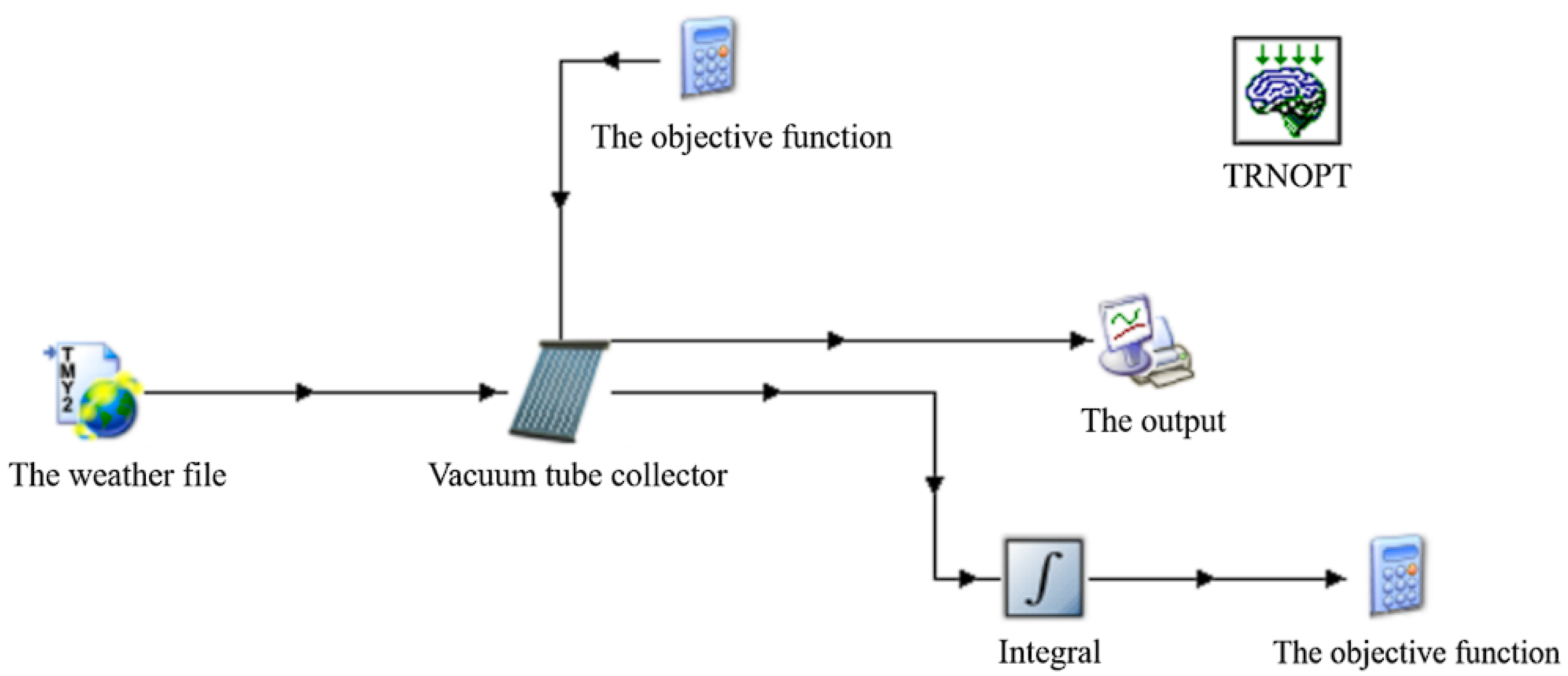
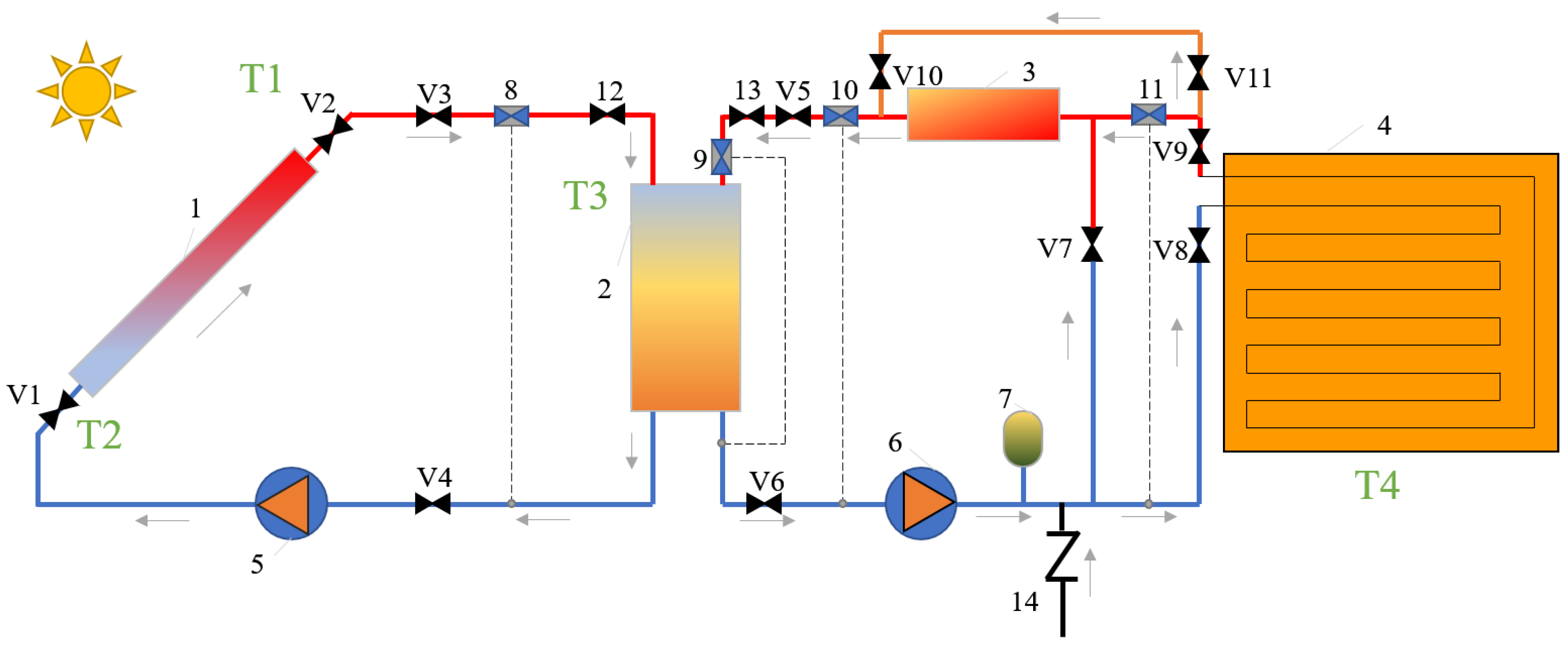
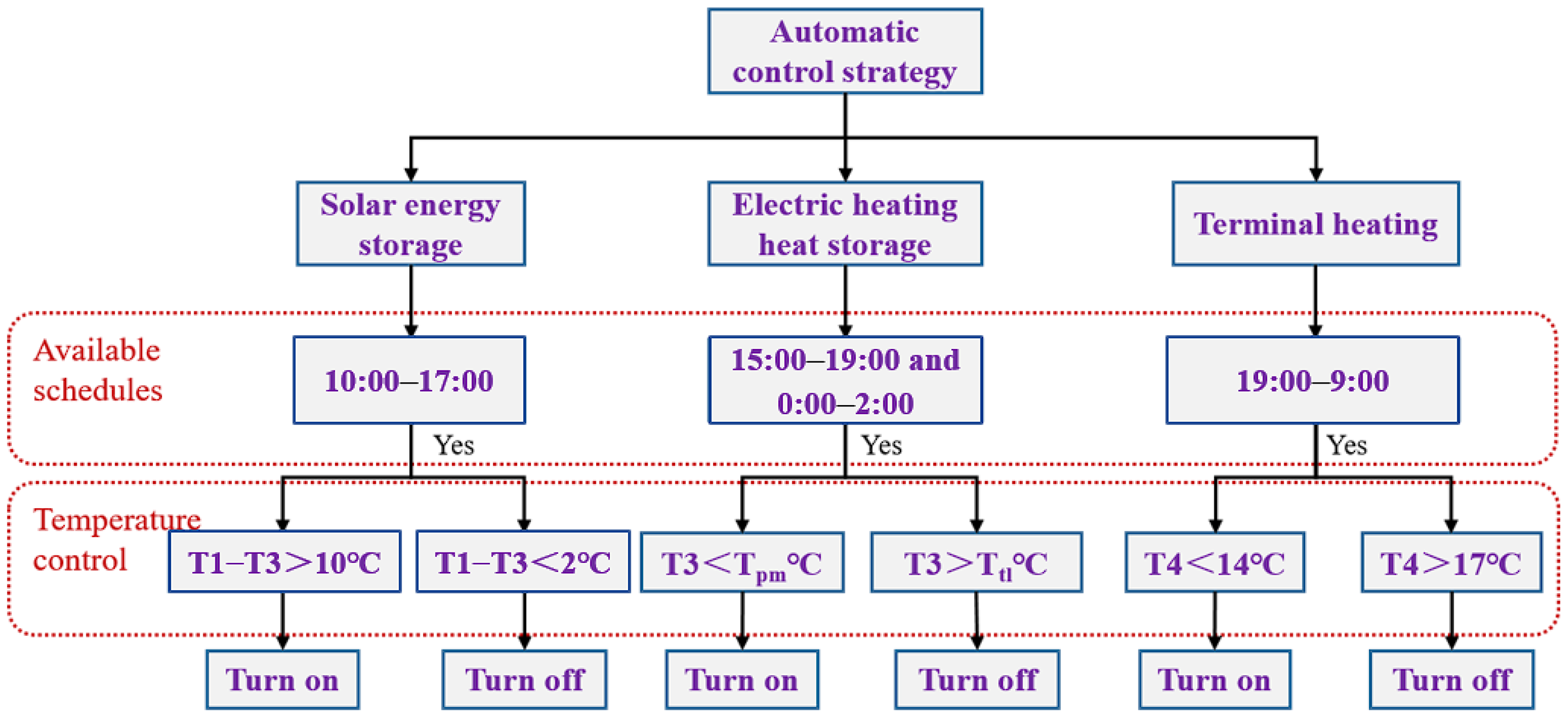
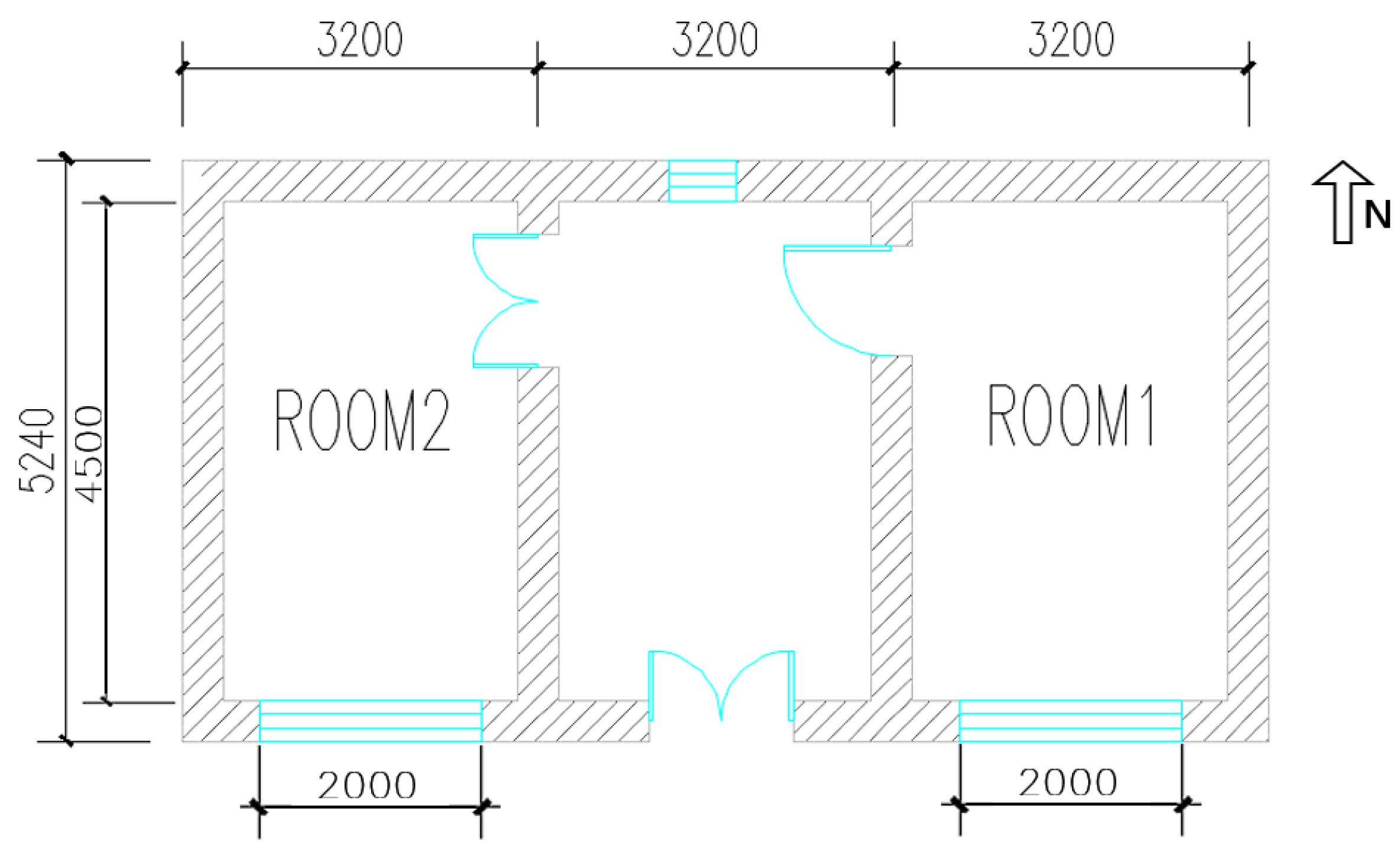

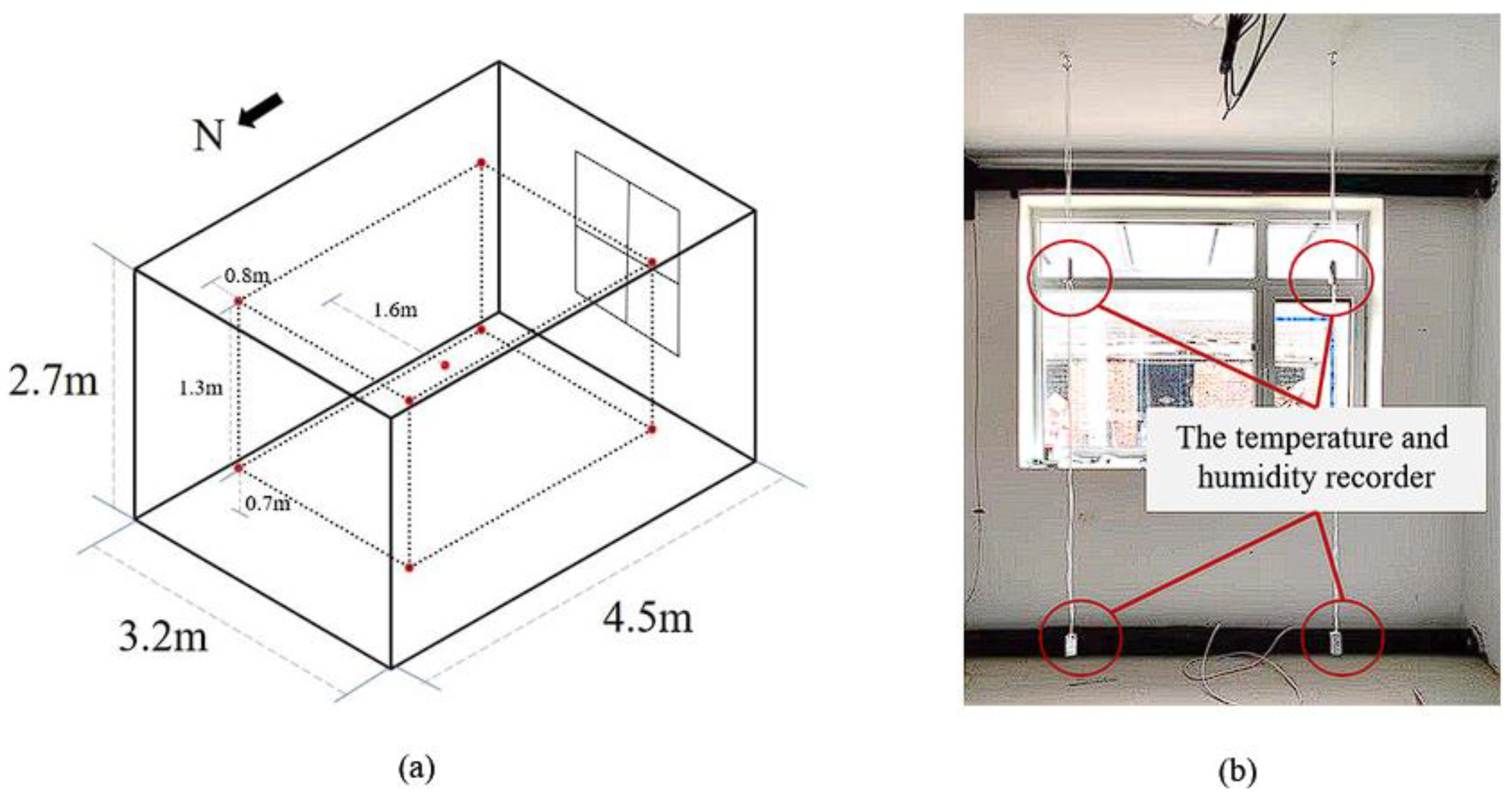
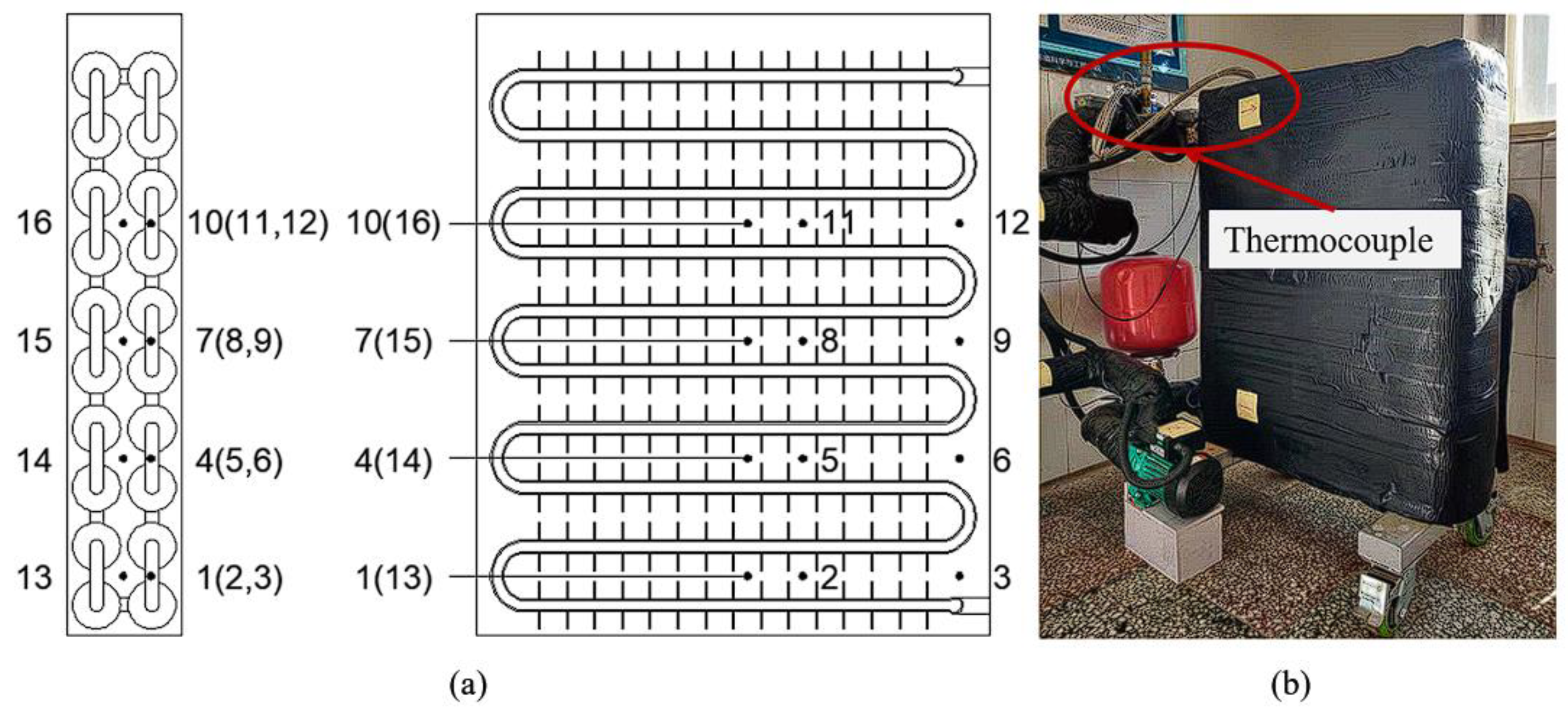
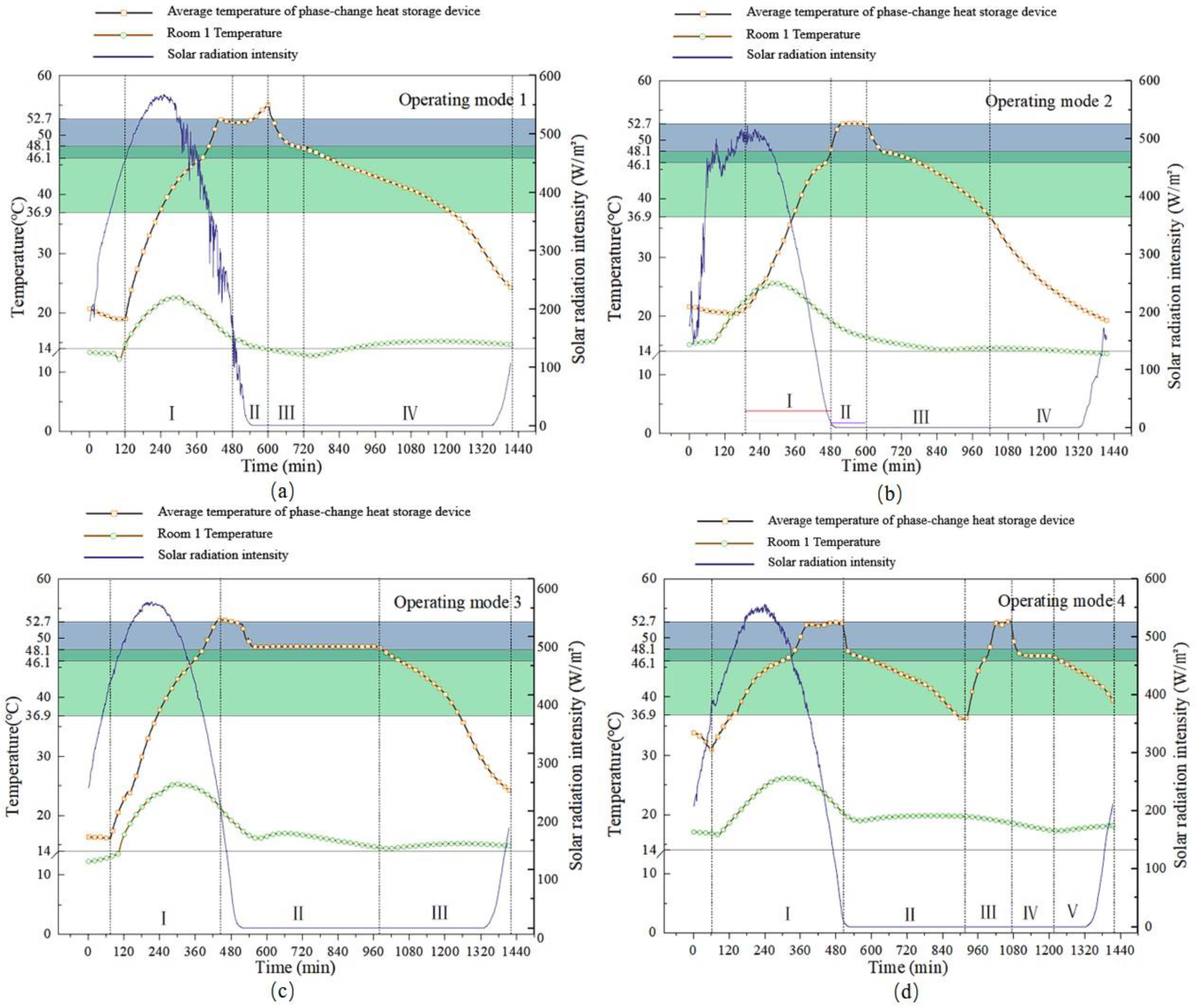
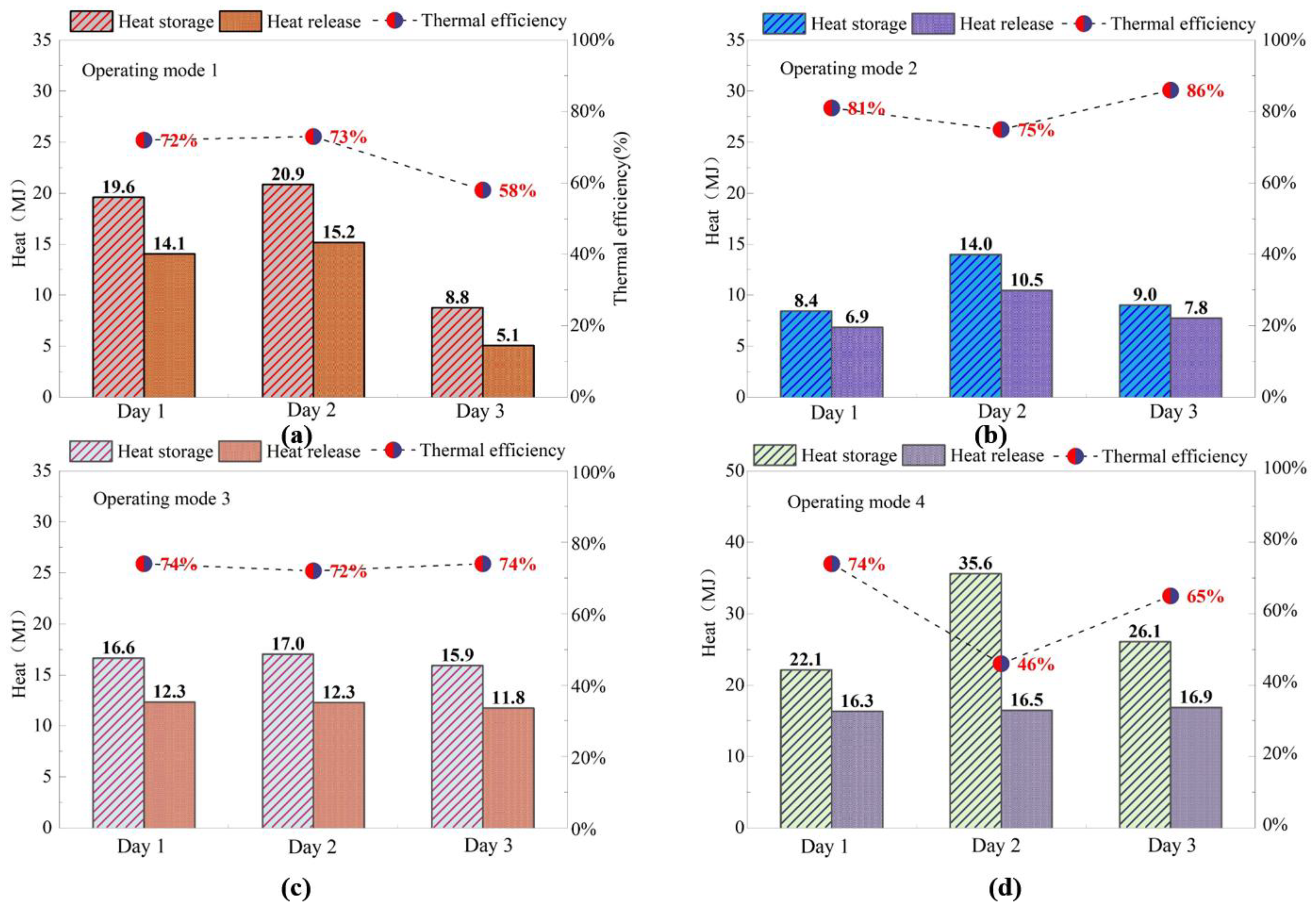
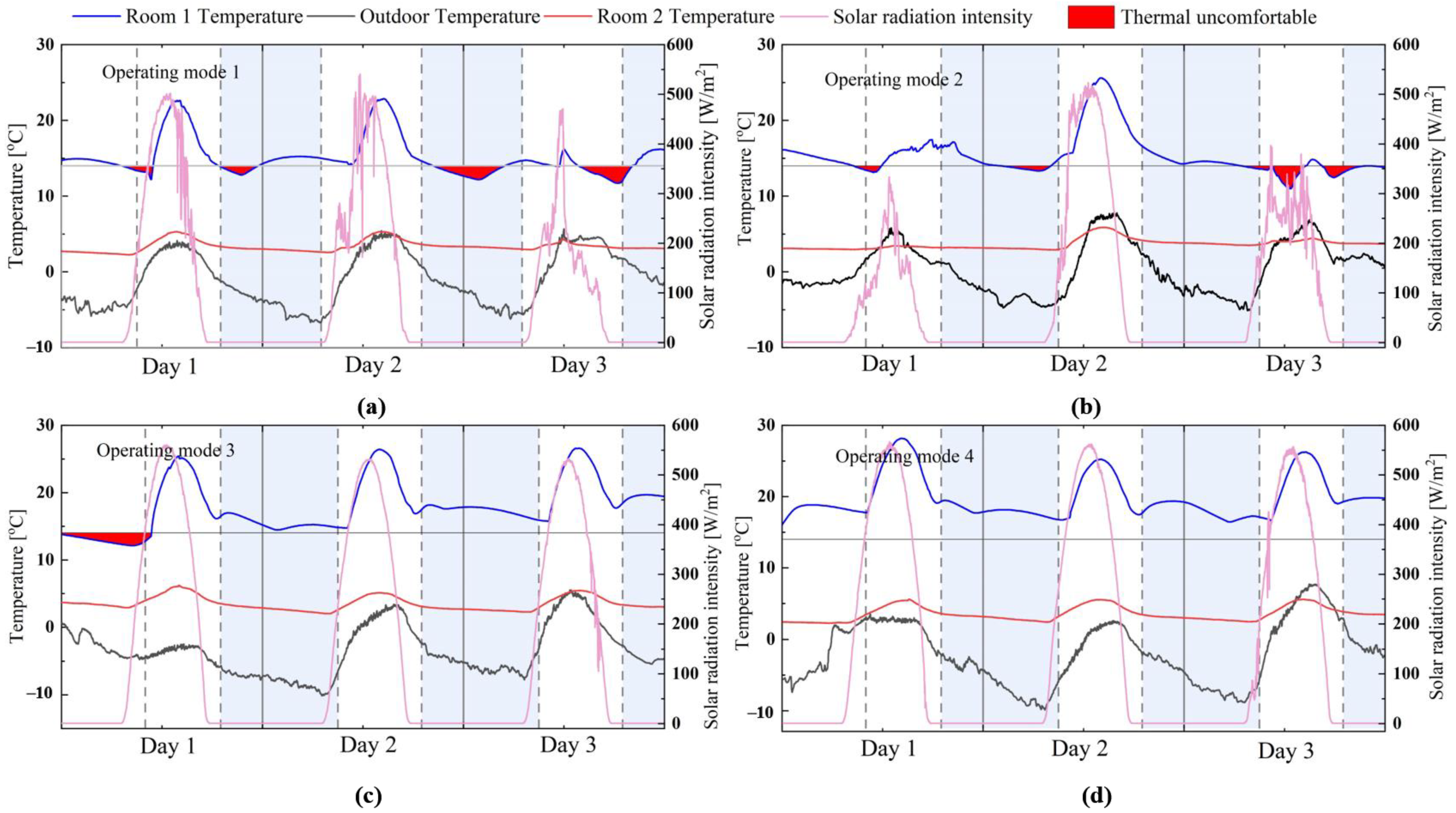
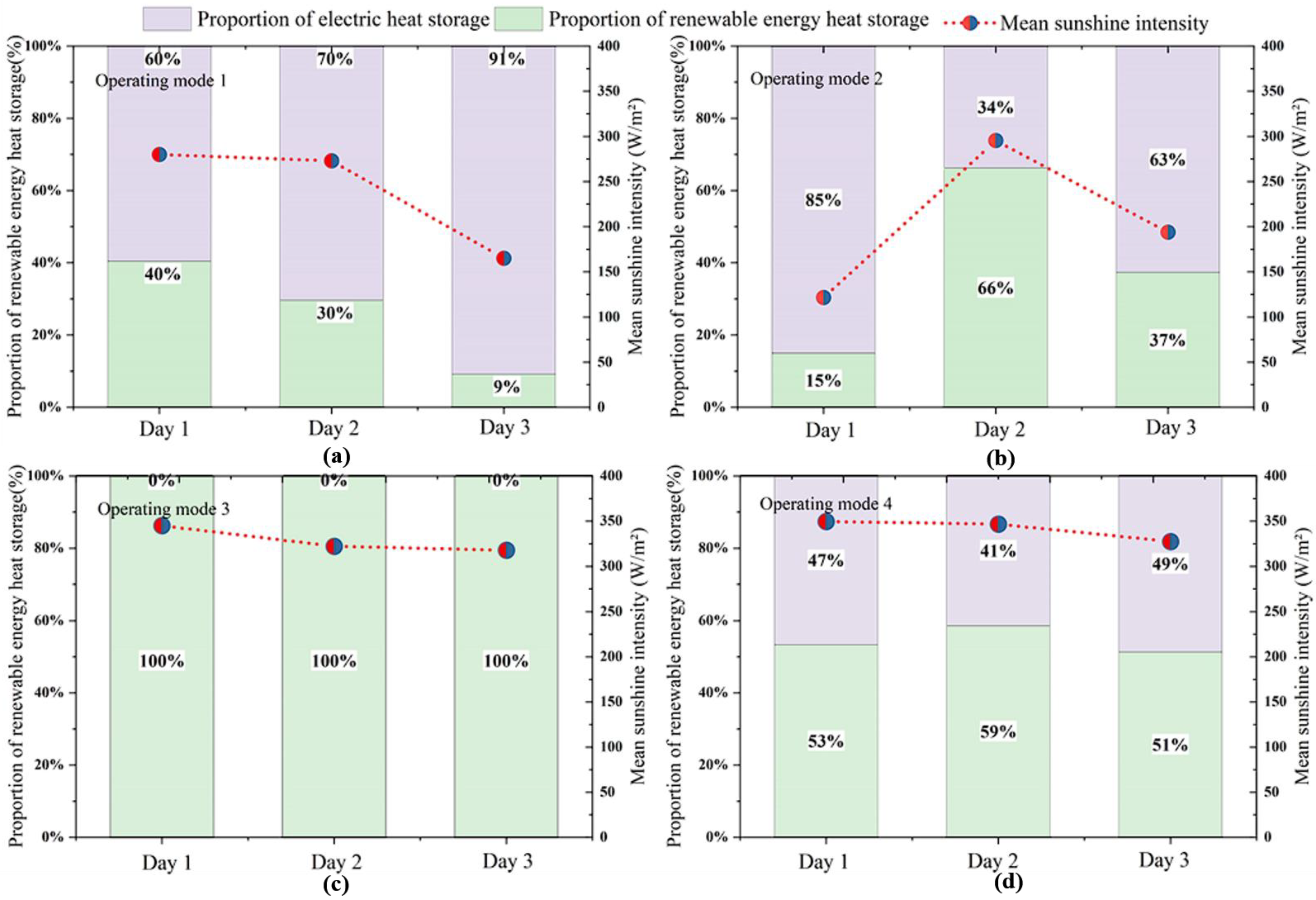
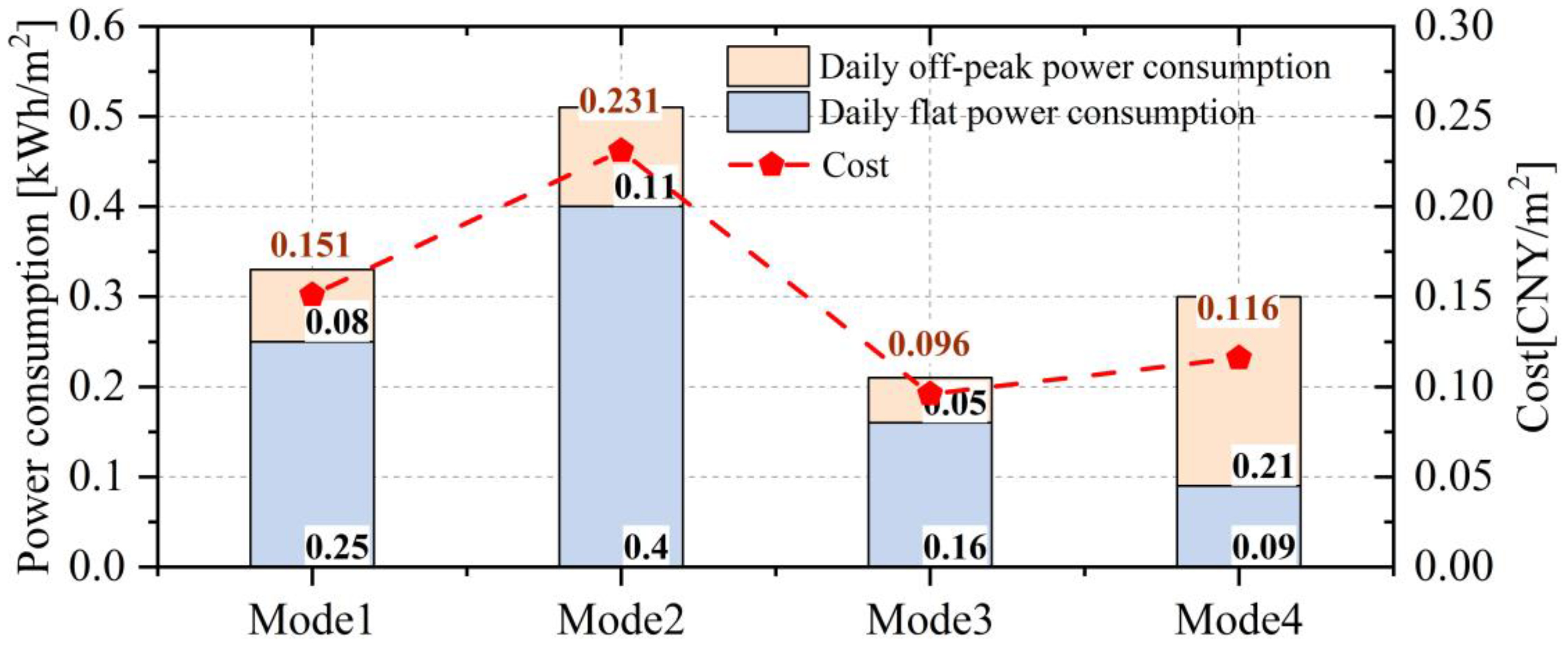
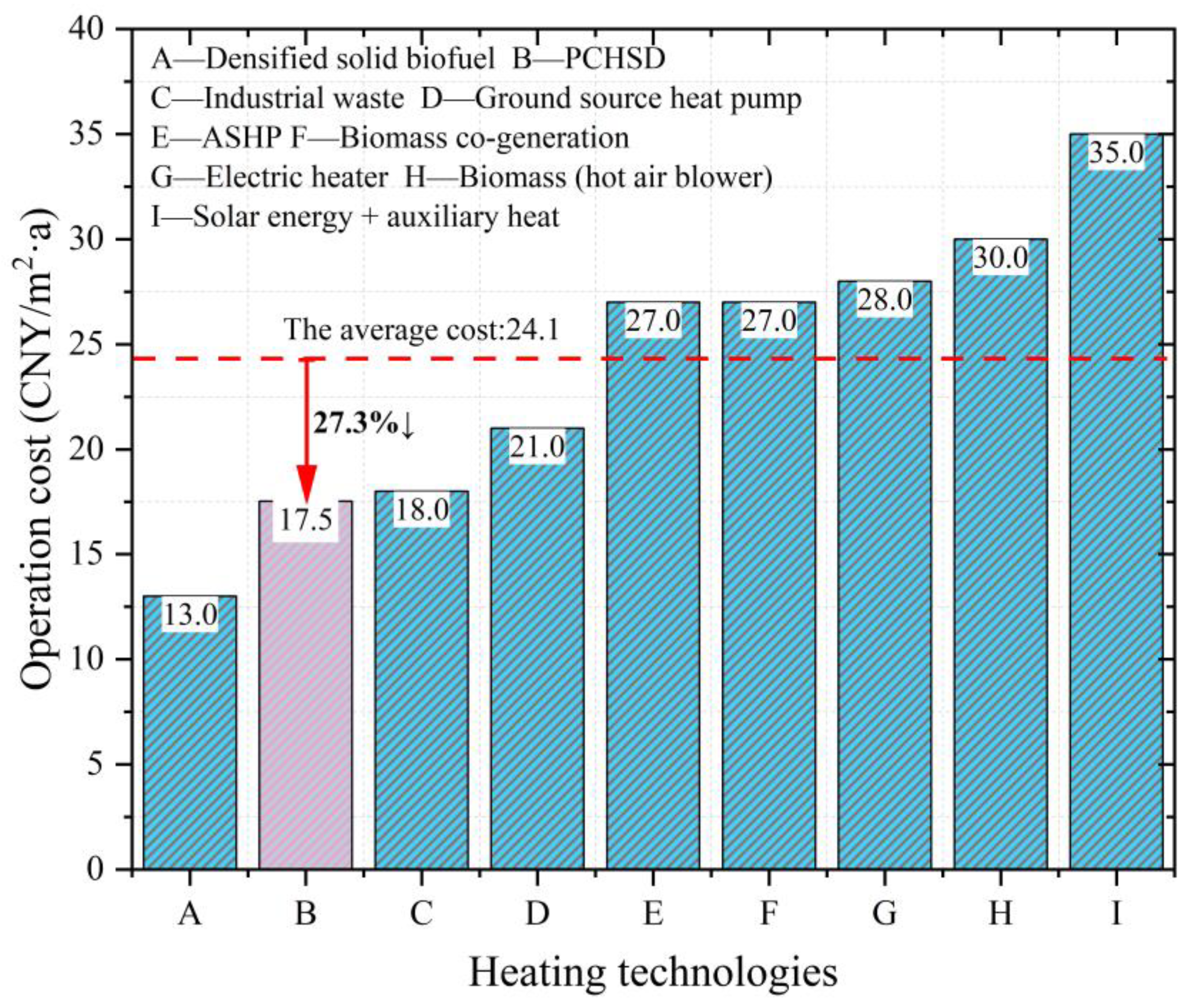
| Physical Parameter | Specific Heat Capacity (J/kg·K) | Thermal Conductivity (W/m·K) | Density (kg/m3) |
|---|---|---|---|
| PCM | 2000 | 0.2 | 860 |
| Water | 4160 | 0.6 | 100 |
| Operating Modes | Operating Characteristics |
|---|---|
| Mode 1 | Solar energy storage + Daytime electric heat storage + Intermittent heating at night |
| Mode 2 | Solar energy storage + Daytime electric heat storage + Continuous heating at night |
| Mode 3 | Solar energy storage + Intermittent heating at night |
| Mode 4 | Solar energy storage + Electric heat storage at night + Intermittent heating at night |
| Type | The Structure of the Envelope | Heat Transfer Coefficient |
|---|---|---|
| Window | 2 m × 1.5 m plastic steel window | 1.6 W/(m2·K) |
| Interior door | 2 m × 1.2 m wooden door | 1.8 W/(m2·K) |
| Wall | 20 mm mixed mortar + 370 solid brick + 15 mm cement mortar screed + 40 mm EPS board + 5 mm finishing layer | 0.53 W/(m2·K) |
| Roof | Tile roof + 80 mm EPS expanded polystyrene board + shed board + wooden keel + ceiling | 0.5 W/(m2·K) |
| Equipment | Parameter |
|---|---|
| Automatic control cabinet | / |
| PCHSD | 740 mm × 160 mm × 930 mm |
| Electric heater | 2 kW |
| Water pump | 0.2 kW |
| Solar collector | 11 m2 |
| Constant pressure water tank | 160 L |
| Radiation floor | 15 m2 |
| Equipment | Model | Operating Range | Accuracy Range |
|---|---|---|---|
| Data acquisition instrument | Agilent 34972A | / | ±0.06% |
| Communication Transmission equipment | USB transfer 485 | / | / |
| Thermocouple | MK01-M6 | L = 3000 mm | K-type |
| Ultrasonic heat meter | RC12 DN20 | Q = 0.025~5 m3/h | ±0.1% |
| Electric meter | 0–45 A | ±0.5% |
Disclaimer/Publisher’s Note: The statements, opinions and data contained in all publications are solely those of the individual author(s) and contributor(s) and not of MDPI and/or the editor(s). MDPI and/or the editor(s) disclaim responsibility for any injury to people or property resulting from any ideas, methods, instructions or products referred to in the content. |
© 2023 by the authors. Licensee MDPI, Basel, Switzerland. This article is an open access article distributed under the terms and conditions of the Creative Commons Attribution (CC BY) license (https://creativecommons.org/licenses/by/4.0/).
Share and Cite
Lv, S.; Zhu, J.; Wang, R. Experimental Research on a Solar Energy Phase Change Heat Storage Heating System Applied in the Rural Area. Sustainability 2023, 15, 2575. https://doi.org/10.3390/su15032575
Lv S, Zhu J, Wang R. Experimental Research on a Solar Energy Phase Change Heat Storage Heating System Applied in the Rural Area. Sustainability. 2023; 15(3):2575. https://doi.org/10.3390/su15032575
Chicago/Turabian StyleLv, Shilei, Jiawen Zhu, and Ran Wang. 2023. "Experimental Research on a Solar Energy Phase Change Heat Storage Heating System Applied in the Rural Area" Sustainability 15, no. 3: 2575. https://doi.org/10.3390/su15032575
APA StyleLv, S., Zhu, J., & Wang, R. (2023). Experimental Research on a Solar Energy Phase Change Heat Storage Heating System Applied in the Rural Area. Sustainability, 15(3), 2575. https://doi.org/10.3390/su15032575






